Wildflower Meadow at Washington Tower
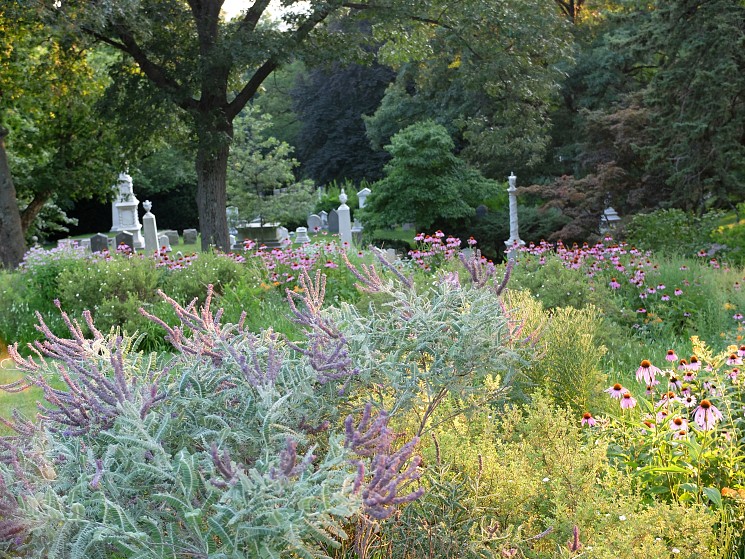
The Wildflower Meadow, a one-acre garden surrounding Washington Tower, was established in 2007. Here, you can find a wide range of drought-tolerant native shrubs, wildflowers, and grasses that add color to the summer landscape and provide beneficial habitat for bees, butterflies, and other pollinators.
On your next visit to Mount Auburn, be sure to enjoy this special area, within our noteworthy landscape. Below is a brief sampling of the plants you’ll find.
Purple Coneflower, Echinacea purpurea, is a popular, long-lasting, daisy-like, flower. The center disk of each flower actually holds a composite of florets, surrounded by reflexed to drooping ray flowers, often a purplish- pink color The genus name is derived from the Greek word echino, for sea urchin, alluding to the spiny, conical, central disk. These are favorite flowers of butterflies, bees, and other insects, and its seeds are eaten by goldfinches, and other species of birds.
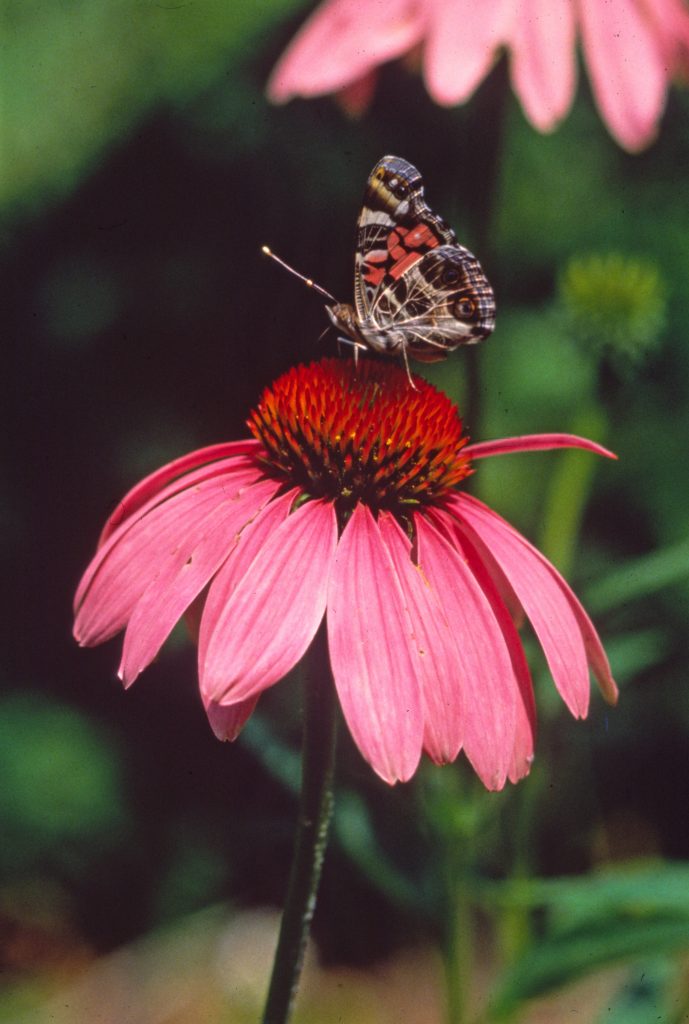
The butterfly was there
Avis Harley
before any human art was made…
Brown-eyed Susan or Branched Coneflower, Rudbeckia triloba, this genus was originally classified by Carl Linnaeus (1707-1778), the father of binomial nomenclature, and named to honor Olaf Rudbeck (1660-1740), Swedish professor of botany. Its two-inch flowers of golden yellow rays, circle around a brown center. The seeds produced by Rudbeckia are food for various species of birds. This is one of several different species of Rudbeckia found growing throughout our landscape. This often self-sows effectively, and should increase its population in this meadow over time.
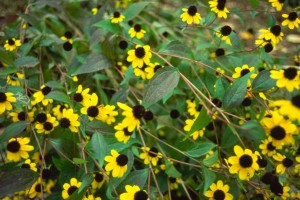
…Knowledge never learned of schools,
John Greenleaf Whittier
Of the wild bees morning chase
Of the wild-flower’s time and place…
Butterfly Weed, Asclepias tuberosa, is a one-to-three-foot, small shrub, which displays intricate, clustered, orange, or yellow, flowers. The genus name commemorates Asklepios, the Greek god of medicine. Though it is a milkweed, the stems do not have milky sap. Hummingbirds are also attracted to these flowers.
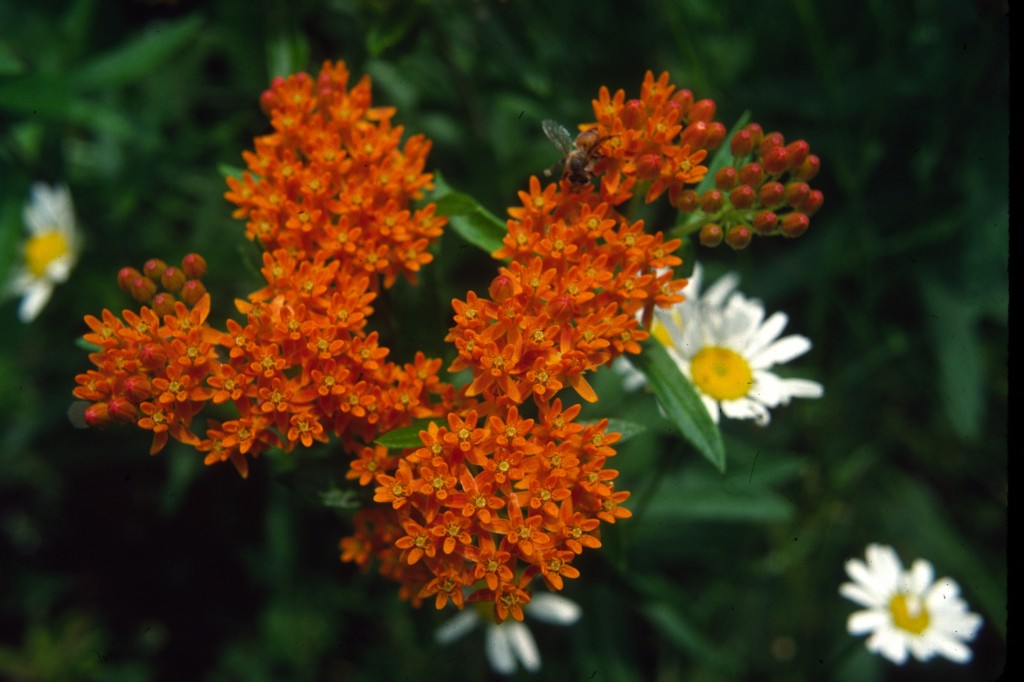
…Finding them butterfly weed when I came
Robert Frost
The mower in the dew had loved them thus,
By leaving them to flourish…
Common Milkweed, Asclepias syriaca, grows three-to-six-feet tall, has broad, thick, oval leaves, with a grayish color on their underside. The umbels of multiple pink, shades of rose, or lavender colored flowers, have a soft, sweet fragrance. The fertilized flowers produce distinctive erect, pointed, gray-green, seed pods which spilt open and spill countless wispy silk-like seeds in the autumn. This especially attracts monarch butterflies, and these leaves are the only food their caterpillars (larvae) will eat, thus, critical for the survival of monarchs.

…though I throw my gasp after a monarch there is no hitch, no hitching either to its serape…
Mina Loy + Arthur Craven
Spotted Mint, Monarda punctata, this thyme-scented member of the mint family, LAMIACEAE, attracts hummingbirds, as well as butterflies and bees. The genus name honors Nicolas Monardes (1493-1588), Spanish physician, botanist, famous for his 1574 book, Medical study of the products imported from our West Indian possessions. The one-inch, yellow, flowers are spotted with purple, and are ringed with larger, showy white, pink, or lilac bracts.
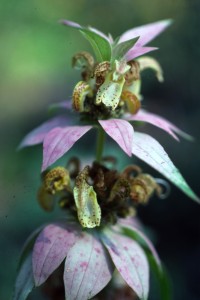
…Where the hummingbird drops in
-Paul Muldoon
to wet his whistle…
Shrubby Cinquefoil, Potentilla fruticosa ‘Pink Beauty’, is a one-to-three-foot tall, shrub in the rose family, ROSACEAE, which bears small, pink flowers, at the ends of the branches, throughout most of the summer. This is within a large genus, having 300 species, found across the northern continents. The genus name is from the Latin potens, for powerful, and refers to some of these plants used as medicines during the Middle Ages. This is another good choice for attracting butterflies, and bees. The larvae of skipper butterflies eat these leaves.
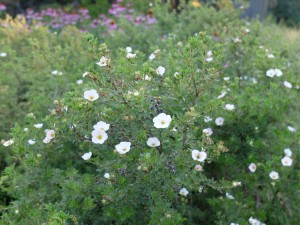
…On noiseless wing a ‘wildered butterfly,
Robert Frost
Seeking with memories grown dim o’er night
Some resting flower of yesterday’s delight
Leadplant, Amorpha canescens, is a one-to-three-foot tall, shrub in the pea family, FABACEAE, which displays four-to-eight-inch, spike-like clusters of small purple flowers, with gold anthers. The Lady Bird Johnson Wildflower Center webpage states that, “The genus name, from the Greek amorphous (formless or deformed), alludes to the fact that the flower, with only a single petal (the banner or standard), is unlike typical pea flowers of the family.” Canescens is a botanical Latin term meaning “becoming gray”, and aptly alludes to the compound leaves which have a dense pubescence, giving the plant a grayish appearance.
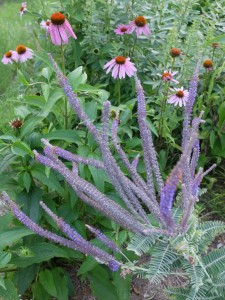
One summer day,
Cole Porter
I chanced to stray
To a garden of flowers blooming wild.
It took me once more
To the dear days of yore
And a spot that I loved as a child….
Leave a Reply